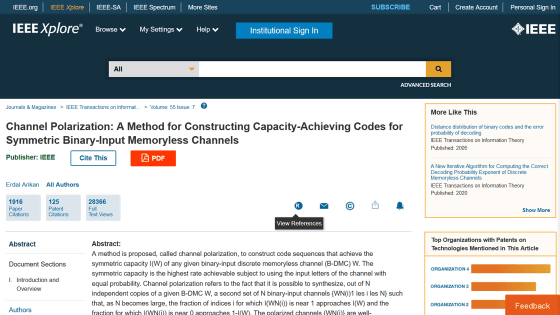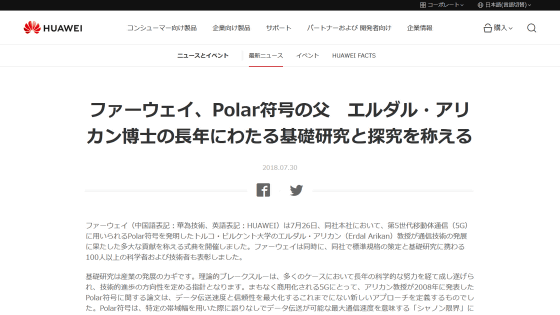What is the key technology that inspired Huawei to lead the world in 5G?

Huawei, a Chinese telecommunications equipment manufacturer, is a world leader in the field of
Huawei, 5G, and the Man Who Conquered Noise | WIRED
https://www.wired.com/story/huawei-5g-polar-codes-data-breakthrough/
How the US missed its chance to own the tech that helped Huawei win 5G | Android Central
https://www.androidcentral.com/how-us-missed-chance-to-own-the-tech-that-helped-huawei-win-5g
Android Central, a technology-related overseas media, said that the reason why the United States embarked on Huawei's regulation is not only because of information and communication risks, but also because of the trillions of dollars (hundreds of trillion yen) of revenue obtained from 5G network compatible devices. Pointed out that it is one. 'Communism, especially China, is considered evil, and the trillions of dollars spent on China are unacceptable to many Western countries,' said Android Central.
Huawei has so much power in the field of 5G networks that Huawei researchers have announced a state-of-the-art data communication approach announced by Professor Erdal Arıkan, who studies information theory at Bilkent University in Turkey. It seems that it was because he paid attention to it early.

Since then, error correction codes such as turbo code and low density parity check code (LDPC) have been implemented in order to remove noise from data communication and approach the communication path capacity (Shannon limit) , which is the upper limit of communication capacity. LDPCs in particular play an important role in Qualcomm 's 5G network technology and are a very robust and practical method.
On the other hand, in the 1980s, more than 30 years after the problem of the Shannon limit was known, research aimed at achieving the Shannon limit was declining. However, Mr. Alkan, who studied information theory in the United States as an international student from Turkey, focused on research on the limits of Shannon, and even after he got a job at Bilkent University in Turkey, he continued his research independently for 20 years.
And Alkan said that by using a new process called 'channel polarization' to generate 'noisy channels' and 'less noisy channels,' error correction codes that could theoretically reach the Shannon limit. Created a certain ' Polar Code '. Alkan improved the theory over the two years since its inception and published a paper in 2009.
Channel Polarization: A Method for Constructing Capacity-Achieving Codes for Symmetric Binary-Input Memoryless Channels-IEEE Journals & Magazine
https://ieeexplore.ieee.org/document/5075875

At first, Alcan thought the theory was great, but even if it was implemented, it was unlikely to be comparable to existing error correction codes and was not practical. Still, in 2011, he explained his ideas to American companies Qualcomm and Seagate and confirmed whether they were interested in implementation, but it seems that no company was interested.
However, in 2012, Huawei researcher Wen Tong found a possibility in Alcan's theory and contacted Alcan. Mr. Tong was a former researcher at Nortel Networks, a telecommunications equipment manufacturer in Canada, who was hired by Huawei after the collapse of Nortel in 2009. Mr. Tong seems to have been paying attention to Polar Code as of 2009, but in 2012 he got the opportunity to assign excellent young engineers to Polar Code research, so he decided to work on Polar Code practical use again. He said he decided.
In 2013, Huawei approved a $ 600 million budget for 5G research, most of which was allocated to Polar Code research. Huawei then came up with software to implement the theory, and at the time of writing, Huawei holds more than two-thirds of the Polar Code-related patents. 'Huawei spends a lot of time and effort developing Polar Code, and other competitors are a few years behind,' said Alexander Vardy, an information scientist at the University of California. I did.

by Kārlis Dambrāns
Of course, if the Polar Code is implemented in the development of 5G technology but was about to Huawei's investment is wasted, which is a standardization project of the communication system 3GPP is in 2016, the world standard technology of the wireless connection in the 5G network 5G Polar Code has been adopted as part of NR . As a result, Huawei devices that can use the Polar Code technology that Huawei has researched as standard can use better data communication than competitors, Android Central points out.
Huawei held a ceremony in honor of Mr. Alkan, who invented Polar Code, and Mr. Ren Zhengfei, the founder and CEO of Huawei, presented Mr. Alkan with a medal directly. 'I was a scholar who didn't know how to promote an idea,' said Alkan. 'Without the tenacious efforts of Huawei researchers, Polar Code wouldn't be in 5G today.'
Huawei honors Dr. Erdal Arıkan, father of Polar Code, for many years of basic research and quest-Huawei Japan
https://www.huawei.com/jp/news/jp/2018/hwjp20180730e

Android Central pointed out that the reason why the United States is lagging behind 5G technology is that American companies were not active in developing 5G network equipment and that companies refused to sell Mr. Alkane. Even if the United States tries to prevent the introduction of Huawei products, it is difficult to prevent the introduction of Huawei equipment in countries in Asia, Africa, the Middle East and South America. In addition, Android Central said that companies other than Huawei need to obtain many technology licenses from Huawei, which has important technology, for the development of 5G network equipment.
Related Posts:
in Web Service, Hardware, Posted by log1h_ik






